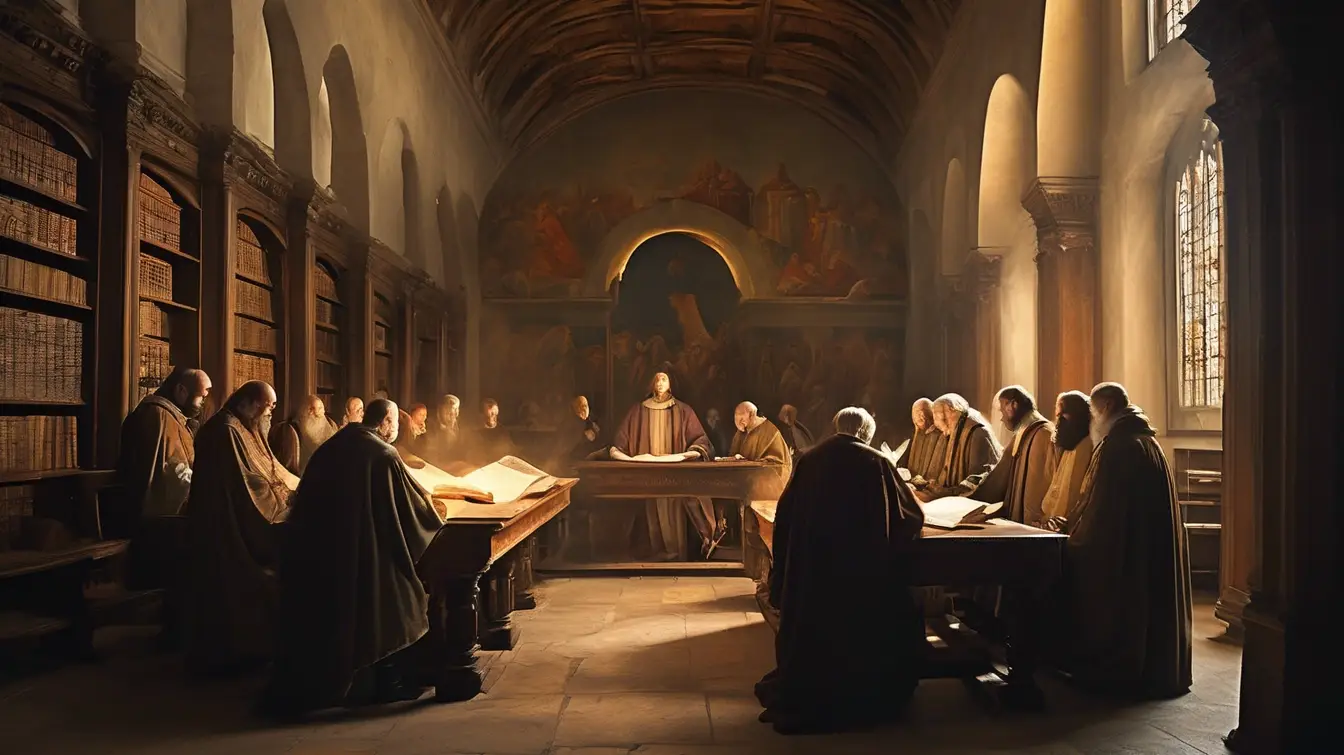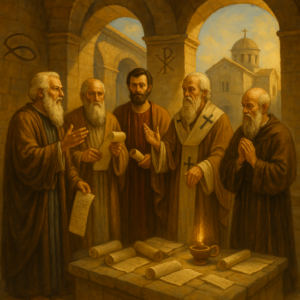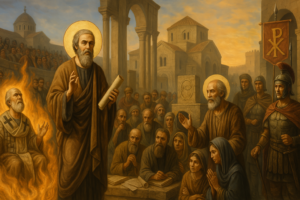
Estimated reading time: 15 minutes
Key Takeaways
- The early church fathers were instrumental in shaping the beliefs and practices of Christianity.
- Their writings addressed critical challenges, including doctrinal disputes and heresies threatening Christian unity.
- Key figures include Saint Ignatius of Antioch, St Justin Martyr, Irenaeus of Lyons, Tertullian, Origen, and Polycarp of Smyrna.
- Their teachings and writings provide invaluable insights into early Christian beliefs before the New Testament canon was firmly established.
- Understanding their influence is crucial for appreciating the development of Christian doctrine and theology.
Table of Contents
- Historical Background of the Early Church Fathers
- The Emergence of the Apostolic Fathers
- From Clement of Rome to Augustine
- Key Figures Among the Early Church Fathers
- Saint Ignatius of Antioch
- St Justin Martyr
- Irenaeus of Lyons
- Tertullian and Origen
- Polycarp of Smyrna
- Other Notable Fathers
- Writings of the Early Church Fathers
- Importance of Early Christian Writings
- Detailed Look at Specific Works
- Teachings and Beliefs of the Early Church Fathers
The early church fathers were instrumental in shaping the beliefs and practices of Christianity, laying the groundwork for doctrines that still influence the faith today. These influential theologians and leaders emerged during Christianity’s formative years, guiding the church through persecution, heresy, and cultural challenges while preserving and developing the teachings passed down from the apostles.
Their writings and teachings addressed critical challenges faced by the early church, including doctrinal disputes and various heresies that threatened the unity and integrity of Christian belief. Through their careful articulation of faith principles, they contributed significantly to the formation of Christian doctrine that remains foundational across denominations today.
In this exploration, we’ll delve into the lives and contributions of key figures like Saint Ignatius of Antioch, St Justin Martyr, Irenaeus, and others who bridged the gap between apostolic Christianity and the established church of later centuries. Their intellectual rigor, spiritual devotion, and unflinching commitment to orthodox belief continue to instruct and inspire believers today.
Historical Background of the Early Church Fathers
The Emergence of the Apostolic Fathers
The Apostolic Church Fathers represent the first generation of Christian writers who had direct connections with the Apostles themselves. These leaders emerged in the late first and early second centuries as Christianity spread throughout the Roman Empire. The Apostolic Fathers preserved the teachings of the Apostles through their writings, providing invaluable insights into early Christian beliefs before the New Testament canon was firmly established.
The apostolic fathers writings create an essential link between the New Testament era and later Christian development. Figures like Clement of Rome, Ignatius of Antioch, and Polycarp of Smyrna wrote letters addressing practical concerns in early Christian communities while reinforcing apostolic teachings.
This period of early Christian writings developed against a backdrop of significant challenges. The church faced persecution from Roman authorities, skepticism from Jewish communities, and competition from pagan religions and philosophies. Additionally, internal theological questions began to arise that required careful articulation of Christian beliefs. The early church fathers history reveals how these leaders navigated these challenges while maintaining the integrity of the faith.
From Clement of Rome to Augustine
The timeline of church fathers from Clement of Rome to Augustine spans approximately four centuries, during which Christianity transformed from a persecuted sect to the dominant religion of the Roman Empire. This progression reveals the development of Christian thought and practice across generations.
Clement of Rome (late 1st century), addressed church order and authority in his letter to the Corinthians. Ignatius of Antioch (early 2nd century) emphasized church unity under episcopal leadership. Justin Martyr (mid-2nd century) engaged with Greek philosophy to defend the faith. Irenaeus of Lyons (late 2nd century) combated Gnosticism and established principles for interpreting scripture.
By the 3rd century, Tertullian in North Africa and Origen in Alexandria were developing more systematic approaches to theology, though in very different directions. The 4th century saw figures like Athanasius defending orthodox views of Christ’s divinity, while the Cappadocian Fathers refined Trinitarian doctrine.
Finally, Augustine of Hippo (354-430 AD) capped this early period with profound explorations of grace, original sin, and divine sovereignty that would shape Western Christianity for centuries to come.
Key Figures Among the Early Church Fathers
Saint Ignatius of Antioch
Saint Ignatius of Antioch served as the third bishop of Antioch in Syria following the apostolic era. According to tradition, he was a disciple of the Apostle John and was appointed to his position around 69 AD. His leadership came during a critical transitional period for the early church, and he ultimately gave his life for the faith, being martyred in Rome around 110 AD under Emperor Trajan.
The Ignatius of Antioch writings consist primarily of seven authentic letters written while he was being transported to Rome for execution. These letters were addressed to various churches in Asia Minor and Rome, offering encouragement, instruction, and warnings against false teachings. His epistles to the Ephesians, Magnesians, Trallians, Romans, Philadelphians, Smyrnaeans, and to Polycarp provide a unique window into early church structure and theology.
Several consistent themes emerge across his letters:
- The importance of church unity under the leadership of bishops
- Warnings against docetic heresy (which denied Christ’s physical body)
- Emphasis on the Eucharist as the center of church life
- The value of martyrdom as witness to faith
Ignatius consistently emphasized the reality of Christ’s incarnation and suffering against those who claimed Jesus only “appeared” to have a physical body. He wrote to the Smyrnaeans: “He was truly born, truly lived, truly ate and drank, was truly crucified, and died in the sight of heaven and earth and the underworld. He was also truly raised from the dead.” [link]
St Justin Martyr
St Justin Martyr stands as one of the most important early Christian apologists. Born around 100 AD in Samaria to pagan parents, Justin was educated in Greek philosophy. After exploring various philosophical schools including Stoicism, Aristotelianism, Pythagoreanism, and Platonism, he encountered Christianity and found it to be “the only safe and profitable philosophy.” His conversion around 130 AD led to him establishing a Christian philosophical school in Rome.
The Justin Martyr writings that survive include his First Apology (addressed to Emperor Antoninus Pius), his Second Apology (a supplement to the first), and his Dialogue with Trypho (a record of debates with a Jewish scholar). These works represent the earliest sustained intellectual defense of Christianity to outside audiences.
In his apologetic works, Justin:
- Defended Christians against charges of atheism and immorality
- Used Greek philosophical concepts to explain Christian beliefs
- Identified elements of truth in Greek philosophy as “seeds of the Word”
- Countered misunderstandings about Christian worship and practices
Justin provided one of the earliest detailed descriptions of Christian worship, including baptism and the Eucharist. He writes: “And this food is called among us the Eucharist… For not as common bread and common drink do we receive these; but in like manner as Jesus Christ our Saviour, having been made flesh by the Word of God, had both flesh and blood for our salvation, so likewise have we been taught that the food which is blessed by the prayer of His word, and from which our blood and flesh by transmutation are nourished, is the flesh and blood of that Jesus who was made flesh.” [link]
Justin was beheaded in Rome around 165 AD under the reign of Marcus Aurelius, living out the faith he so eloquently defended.
Irenaeus of Lyons
Irenaeus of Lyons provides a crucial link to apostolic teaching. Born in Asia Minor around 130 AD, he studied under Polycarp of Smyrna, who was himself a disciple of the Apostle John. This connection gave Irenaeus special authority in articulating authentic Christian tradition. Later, Irenaeus served as a presbyter in Gaul (modern France) before becoming bishop of Lyon around 177 AD following the martyrdom of his predecessor.
The Irenaeus writings that survive include his monumental five-volume work “Against Heresies” (Adversus Haereses) and the shorter “Demonstration of Apostolic Preaching.” His works primarily combat Gnosticism, a collection of philosophical-religious movements that claimed special knowledge (gnosis) was necessary for salvation.
In his Irenaeus against heresies writings, he developed several key theological principles:
- The concept of apostolic succession as a guarantee of doctrinal continuity
- The importance of the four canonical gospels against competing narratives
- The unity of the Old and New Testaments against those who rejected Hebrew scriptures
- The “recapitulation” theory of salvation, where Christ undoes Adam’s disobedience
Irenaeus emphasized that legitimate church teaching could be traced through an unbroken succession of bishops back to the apostles. He wrote: “It is possible, then, for everyone in every church, who may wish to know the truth, to contemplate the tradition of the apostles which has been made known throughout the whole world.” [link]
Tertullian and Origen
Tertullian (c. 155-220 AD) was born in Carthage (modern Tunisia) to pagan parents and trained as a lawyer before his conversion to Christianity around 197 AD. His legal training informed his apologetic works, which logically defended Christianity against pagan accusations. He was the first significant Christian writer to work in Latin rather than Greek, earning him the title “father of Latin Christianity.”
Tertullian’s contributions to early Christian theology were substantial:
- He coined the term “Trinity” (Latin: trinitas) to describe God’s three-personed nature
- He developed language about the two natures of Christ that influenced later Christology
- He produced practical writings on Christian living, including fasting, prayer, and marriage
- He defended the faith against Roman persecution in works like “Apology”
Later in life, Tertullian was drawn to the Montanist movement, which emphasized prophetic gifts and strict asceticism, leading some to question his orthodoxy.
Origen (c. 185-253 AD) was born in Alexandria, Egypt to Christian parents. His father was martyred in the persecution under Septimius Severus. Remarkably prolific, Origen reportedly wrote nearly 2,000 works, though many have been lost. He founded a Christian school in Alexandria and later worked in Caesarea.
The early church fathers commentary on Scripture reached its pinnacle with Origen, whose works included:
- The Hexapla: a massive textual comparison of the Old Testament in six columns
- Commentaries on most books of the Bible
- “On First Principles” (De Principiis): an early systematic theology
- “Against Celsus”: a defense against pagan criticism
Origen’s theology sometimes ventured into speculative areas that later councils would reject, including ideas about the pre-existence of souls and universal salvation. Nevertheless, his influence on biblical interpretation was immense.
While Tertullian approached Christianity from a legal, practical perspective emphasizing clear boundaries of belief and conduct, Origen engaged with philosophy and allegory, seeking deeper spiritual meanings in scripture. Tertullian’s concept of the Trinity laid groundwork for later definitions by distinguishing the persons while maintaining their unity in substance. [link] [link]
Polycarp of Smyrna
Polycarp of Smyrna holds a special place among the early church fathers as one of the most direct links to the apostolic age. Born around 69 AD, Polycarp became a Christian in his youth and was a disciple of the Apostle John. According to Irenaeus, Polycarp was “instructed by the apostles, and conversed with many who had seen Christ.” He served as bishop of Smyrna (modern Izmir, Turkey) for many decades.
The Polycarp of Smyrna writings that survive are limited to a single letter, his Epistle to the Philippians. This authentic document demonstrates his pastoral concern and deep knowledge of Scripture. In this letter, Polycarp:
- Emphasizes the virtue of righteousness and avoidance of greed
- Provides instruction for different members of the Christian community
- Warns against docetic heresy that denied Christ’s humanity
- References numerous New Testament writings, showing their early acceptance
At the age of 86, Polycarp was arrested during a persecution in Smyrna. When given the opportunity to renounce his faith and save his life, he famously replied: “Eighty-six years I have served him, and he has done me no harm. How can I blaspheme my King who saved me?”
The Martyrdom of Polycarp is one of the earliest accounts of Christian martyrdom outside the New Testament. Written shortly after his death around 155 AD, it describes his arrest, trial, and execution by burning followed by stabbing. This document provided a model for later martyrdom accounts and encouraged Christians facing persecution.
Other Notable Fathers
Clement of Rome (late 1st century) is traditionally identified as the fourth bishop of Rome and possibly a co-worker mentioned by Paul in Philippians 4:3. His First Epistle to the Corinthians is the earliest Christian document outside the New Testament, written around 95-96 AD. This letter addressed divisions within the Corinthian church, emphasizing church order, proper succession of leadership, and the importance of humility. Clement frequently references Old Testament examples and may have known Peter and Paul personally.
Augustine of Hippo (354-430 AD) represents the culmination of patristic thought in Western Christianity. Born in North Africa to a Christian mother (Monica) and pagan father, Augustine initially rejected Christianity for Manichaeism and Neo-Platonism while pursuing a career in rhetoric. After a dramatic conversion in Milan under the influence of Ambrose, Augustine returned to Africa and became bishop of Hippo Regius.
The catholic church fathers writings reached their most influential expression in Augustine’s works, which include:
- “Confessions”: his spiritual autobiography describing his journey to faith
- “The City of God”: a massive defense of Christianity after Rome’s fall in 410 AD
- Theological treatises on grace, free will, and original sin
- Commentaries on Scripture, including the Psalms and John’s Gospel
Augustine’s theology shaped Western Christianity’s understanding of sin, grace, predestination, the Trinity, and biblical interpretation. His emphasis on divine sovereignty and human dependence on grace influenced both Catholic and later Protestant thought.
Many of these foundational texts from the early fathers are now accessible through early church fathers online collections, making it possible to study their original contributions firsthand.
Writings of the Early Church Fathers
Importance of Early Christian Writings
The early Christian writings served as the primary vehicles for preserving and transmitting apostolic teaching after the deaths of the original disciples. These documents emerged during a crucial period when the New Testament canon was still developing, providing essential context for interpreting Scripture and establishing normative Christian belief and practice.
The apostolic fathers writings fulfilled several vital functions in the developing church:
- Maintaining doctrinal continuity with apostolic teaching
- Addressing new challenges not explicitly covered in Scripture
- Defending the faith against internal and external threats
- Providing pastoral guidance to early Christian communities
- Establishing precedents for church order and governance
These writings also played a significant role in the process of defining the New Testament canon. Texts like the Didache, 1 Clement, and the letters of Ignatius show which apostolic writings were considered authoritative in different regions of the early church. Citations and allusions to New Testament documents helped establish which texts were widely recognized as authentic.
Additionally, early church writings were often read alongside Scripture in worship services, especially in commemorating martyrs or on special feast days, highlighting their significance in the community’s spiritual formation.
Detailed Look at Specific Works
Justin Martyr Writings represent some of the earliest intellectual defenses of Christianity to the Roman world. His First Apology (c. 155 AD) addressed Emperor Antoninus Pius, defending Christians against charges of atheism and immorality while explaining Christian beliefs and practices. Justin describes Sunday worship, including readings from “the memoirs of the apostles” (the Gospels), sermon, prayer, and Eucharist.
His Second Apology, addressed to the Roman Senate, continued this defense, particularly explaining why Christians were willing to die for their faith. The Dialogue with Trypho, his longest surviving work, records a discussion with a Jewish scholar about how Jesus fulfills Old Testament prophecies and why Christians do not follow Jewish ceremonial laws.
Ignatius of Antioch Writings consist of seven authentic letters written while being transported to Rome for execution around 110 AD. These letters addressed specific churches (Ephesians, Magnesians, Trallians, Romans, Philadelphians, Smyrnaeans) and one individual (Polycarp). Common themes include:
- Unity under the bishop as representative of God’s authority
- The three-fold ministry of bishop, presbyters, and deacons
- Warnings against docetism, which denied Christ’s physical body
- The centrality of the Eucharist in church life
- His personal anticipation of martyrdom
His letter to the Romans is particularly striking for its passionate desire for martyrdom: “Let me be food for the wild beasts, through whom I can attain to God… I am God’s wheat, and I am ground by the teeth of wild beasts that I may be found pure bread of Christ.”
Irenaeus Writings focus primarily on combating Gnosticism. His five-volume work “Against Heresies” (c. 180 AD) provides both a detailed description of Gnostic beliefs (making it valuable for understanding these lost traditions) and a comprehensive refutation based on apostolic teaching. He emphasizes:
- The role of apostolic succession in preserving authentic teaching
- The four canonical gospels as the authoritative accounts of Jesus
- The unity of creation and redemption against Gnostic dualism
- The recapitulation theory of atonement, where Christ reverses Adam’s failure
His shorter work “Demonstration of the Apostolic Preaching” provides a summary of Christian doctrine designed for instructing believers.
Polycarp of Smyrna Writings survive only in his Letter to the Philippians, which shows his pastoral concern and deep knowledge of apostolic teaching. The letter exhorts believers to virtue, warns against false teachers, and provides instruction for different groups within the church. What makes Polycarp’s letter particularly valuable is his extensive use of New Testament documents, demonstrating their early acceptance as authoritative.
The catholic church fathers writings have been preserved in collections like the Patrologia Latina (217 volumes of Latin texts) and Patrologia Graeca (161 volumes of Greek texts) compiled in the 19th century. Modern translations make these texts accessible to contemporary readers, while early church fathers online resources provide free access to many of these writings through sites like the Christian Classics Ethereal Library, Early Christian Writings, and New Advent.
Teachings and Beliefs of the Early Church Fathers
Formation of Christian Doctrine
The early church fathers played a critical role in the formation of Christian doctrine during a time when the church faced both internal and external challenges. Their writings clarified, defended, and developed the apostolic teachings in response to various heresies that threatened the integrity of the faith.
Several key factors characterized the early church fathers beliefs and their approach to doctrine formation:
- Continuity with Apostolic Teaching: They insisted that legitimate Christian teaching had to maintain continuity with what the apostles had delivered to the churches.
- Rule of Faith: They often referred to a “rule of faith” or “canon of truth” that summarized essential Christian beliefs and served as a measuring stick against which all teachings were evaluated.



